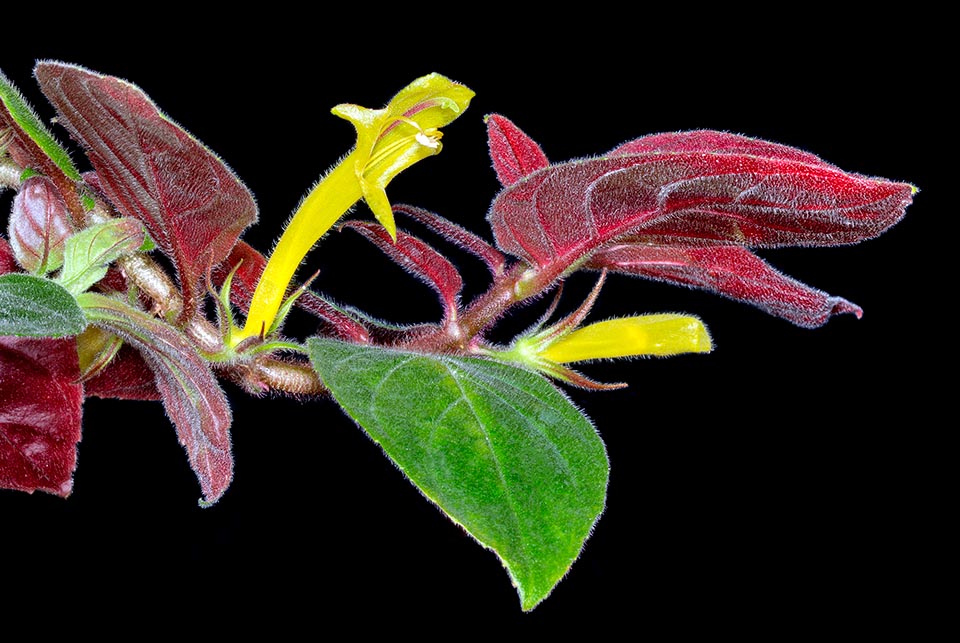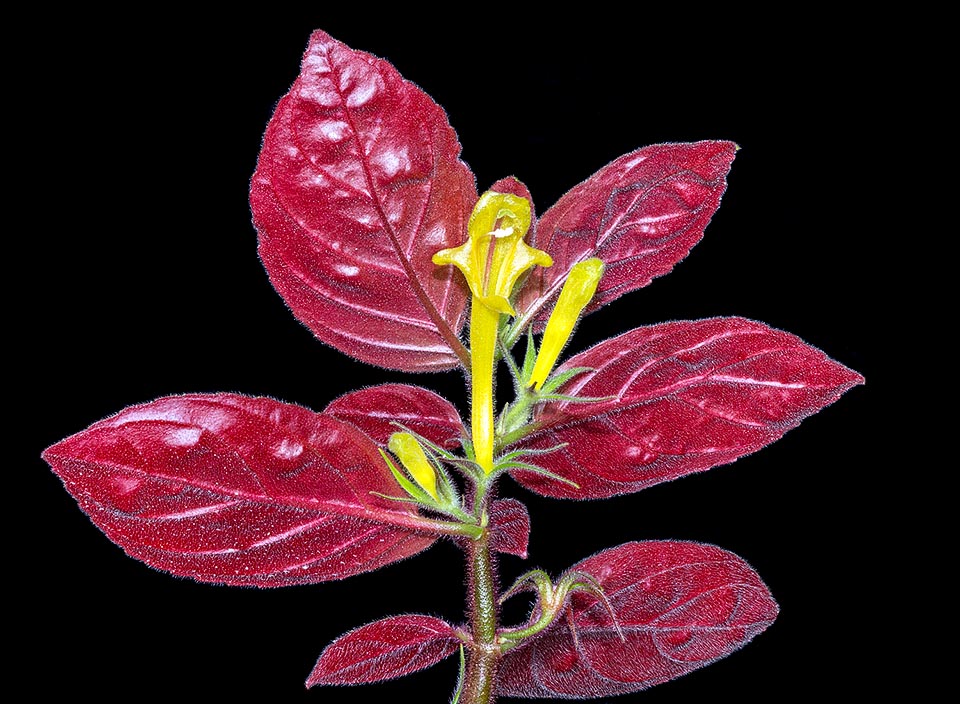Family : Gesneriaceae

Text © Pietro Puccio

English translation by Mario Beltramini
The species is native to Belize, Guatemala and Mexico (Chiapas, Puebla, Tabasco and Veracruz) where it lives on the trees of the humid forests from the sea level up to about 1000 m of altitude.
The genus is honoured to the Italian naturalist Fabio Colonna (1567-1640); the specific name is the Latin adjective “sulfureus, a, um” = sulphurous, of the colour of the sulphur, with reference to the flowers.
Common names: kak’i pim (Q’eqchi’).
The Columnea sulfurea Donn.Sm. (1901) is an epiphyte species with reddish brown hirsute stems, 35-50 cm long and of 3-5 mm of diameter, tendentially hanging, with internodes spaced of 2-4 cm.

The Columnea sulfurea is a little known epiphyte in cultivation native to Belize, Guatemala and Mexico. Alone or in pair, the luminous flowers are sulphur yellow as per the scientific name. They have a 6,5 cm tubular column and wide fauces, like Lamiaceae, back enlarged lobe with 4 yellow stamens and pinkish white style © Giuseppe Mazza
The leaves, on a 3-6 mm long petiole, are simple, opposite, unequal, the biggest from elliptic to oblong-elliptic with acute apex, entire margin or slightly toothed and prominent veins below, 6-11 cm long and 2,5-4 cm broad, dark green above, purple to wine red below, pubescent; the smallest similar, 3-4,5 cm long and 1,8-2,5 cm broad.
Axillar flowers, on a 1-1,5 cm long peduncle, solitary or in pair, calyx with 5 linear lobes with acuminate apex, 2,5 cm long, of green colour more or less suffused of red, pubescent, tubular corolla, about 6,5 cm long, of yellow colour, pubescent, fauces with posterior lobe 3 cm long and 1,5 cm broad, fore one linear oblong with acute apex, 1,5 long, lateral lobes, at right angle, almost triangular with obtuse apex, 1 cm long, 4 yellow stamens, 6 cm long, pinkish white style, 6,5 cm long, and superior ovary.
The fruits are globose berries, of about 1 cm of diameter, fleshy, of pinkish white colour, containing numerous seeds. It reproduces by seed, placed in draining organic loam maintained humid at the temperature of 26-28 °C, and by cutting in spring-summer.

The reddish brown hirsute stems, tendentially hanging, may be 50 cm long. The lower page of the leaves, utilized in Belize as astringent against the diarrhoea, has an unusual wine red or purple colour. Species with undoubtful ornamental characteristics for tropical gardens but also, in pot, for the luminous verandas © Giuseppe Mazza
Little known species in spite of the undoubtful ornamental characteristics, cultivable in open air in the tropical and humid subtropical zones in very luminous zones, but not in the direct sun, in particularly aerated and draining loam, rich of organic substance, maintained almost constantly humid, but without stagnations.
Elsewhere, it is to be kept in pots or baskets, preferably suspended, to be sheltered during the coldest months in particularly luminous protected environment, aerated, with high atmospheric humidity, 75-85 %, and medium-high temperatures, with lowest ones not under the 15 °C. Regular and abundant watering during the vegetative period, but allowing the superficial layer of the substratum to dry up before watering again, more spaced in winter, but without getting it completely dry. For the fertilizations, in spring summer, it can be utilized a hydrosoluble product balanced with microelements with half doses, or less, in respect to those suggested on th package.
In Belize, the leaves are utilized in the traditional medicine as astringent against diarrohea.
→ To appreciate the biodiversity within the GESNERIACEAE family please click here.
